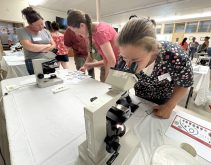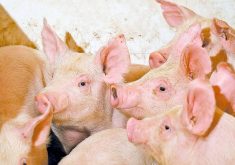Fuelled by the perception that many consumers want an end to the mass culling of male chicks, early-incubation gender identification of eggs continues to be a focus for researchers.
A presentation at the recent Eurotier farm show in Germany, held virtually, indicated a German-Dutch collaboration may have the lead in bringing an effective technology to market.
Why it matters: Animal welfare-related consumer demands could one day provide enough pressure to force a ban on the large-scale male chick culling that is currently an industry norm.
Read Also

Ontario’s agri-food sector sets sights on future with Agri-Food 2050 initiative
The first-ever Agri Food 2050, a one-day industry event dedicated to envisioning the future of food and farming in Ontario,…
However, a quicker Canadian alternative still under development may ultimately gain the upper hand. The Dutch-German system can’t be implemented until the ninth day of incubation.
That Canadian project, supported by a partnership between Egg Farmers of Ontario, the federal government and McGill University, remains in the large-scale tests phase in a commercial hatchery. Known as Hypereye, it was originally slated for commercialization in 2020 but work was delayed at the outset of the COVID-19 pandemic. The lead researcher was recently unable to provide a firm timeline for large-scale roll-out.
The Eurotier presentation, by Respeggt Group chief executive officer Dr. Ludger Breloh, explored the looming legislative hammers being brought down in France and Germany, where draft laws would see culling completely banned as early as 2022.
He said that involves eggs sold at retail, in food service and for industrial scale use. In Germany, large-scale grocery retainers are already lining up culling-free suppliers.
Respeggt is the consumer-facing brand name for the Seleggt gender-determination technology. Seleggt, developed at the University of Leipzig, draws a minuscule amount of amniotic fluid from the egg through a laser-bored hole and analyzes its hormone content to determine gender. It was first tested in April 2018, saw its first culling-free eggs marketed on a very small scale in Berlin later that year, and saw eggs first analyzed by a fully automated machine in November 2019.

The male eggs are diverted into pet food or another non-fresh egg supply chain.
Currently, the technology has been installed in a single hatchery in the Netherlands, and eggs bearing the “Respeggt” stamp are being marketed in Germany at a significant price premium. These eggs come not only from the hatchery using the Seleggt technology but also from hatcheries that can certify that male chicks coming from their facilities are not slaughtered but sent into a separate meat-from-male-chickens supply chain.
Breloh cautioned, however, that raising male chicks from hatcheries cannot be a long-term or large-scale solution. Decades of genetics have created egg-laying breeds of chicken that cannot compete, feed efficiency-wise, with the common meat-producing breeds.
He could not foresee a future when consumers would willingly pay more for lesser-quality meat from male chickens compared to regular chicken, simply because it contributed to culling-free eggs.
He conceded there may be a place for stronger genetics programs for dual-purpose breeds. But as the demand for culling-free eggs grows, Breloh said that gender-identification technologies are the only path forward.
One significant concern for Seleggt/Respeggt is the stipulation in the draft German legislation that gender identification should occur within six days of the start of incubation. Seleggt currently ensures 97 per cent accuracy (those three per cent males from the Netherlands hatchery are sent with the females to the participating Respeggt farms, then slaughtered at 13 weeks) when analyzed on the ninth day.
Seleggt wanted the legislation changed. “The Research Services of the German Bundestag has stated that the perception of pain is possible (in chick embryos) from the 15th day of incubation,” the company’s website states.
In France, the draft legislation calls for gender identification by the 10th day of incubation.
But in Canada, those championing Hypereye have no such concerns. The technology, developed by a team led by McGill’s Dr. Michael Ngadi, analyzes the colour of light reflected by eggs on hatching day to determine gender.
Likewise in Australia, a team developing eggs with specific light-reflecting qualities through CRISPR technology would also see their method implemented on the day the egg is hatched.
Another possible stumbling block for wider-scale adoption of any of the technologies is the speed with which eggs can be effectively analyzed. Here as well, the Canadian technology may have an edge.
The original Seleggt machine installed in the Netherlands hatchery analyzed 60,000 eggs per week. But in April of this year, the company announced it had perfected a new, commercially available model that can handle 360,000 eggs per week.
When the Hypereye project was initially announced, including an $844,000 boost from the federal government-funded Canadian Agricultural Adaptation Program, the stated goal for egg analysis was 20,000 per hour. At 40 hours per week, this translated into 800,000 eggs per week.
“Further tests are ongoing, including the construction of an optimized system,” Ngadi told Farmtario.















